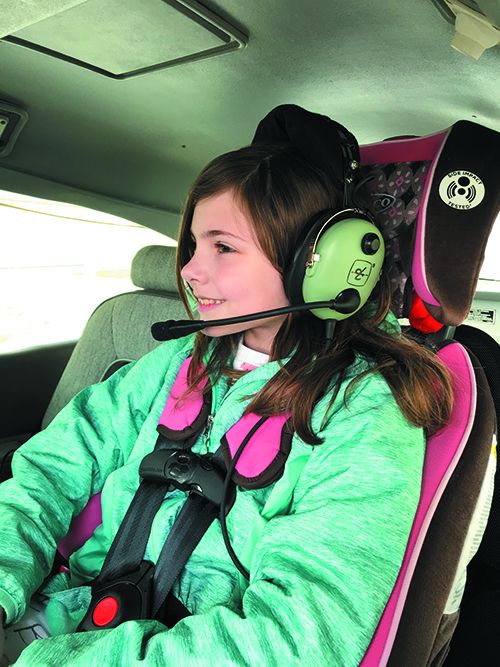Headsets for kids serve three purposes: They protect hearing, they keep kids entertained by providing a source of music and they allow kids to be part of the conversation in the airplane.
But there are several challenges, including finding a model with the right balance of comfort, features and durability. No, kids aren’t easy on headsets, so they need to be rugged. There’s also the concern about dropping a lot money on a set that a kid will grow out of.
Since Aviation Consumer hasn’t looked at the market for youth headsets in a number of years, I scanned the market and collected a handful of samples to try in a piston single. Here’s a field report.
THE PROCESS
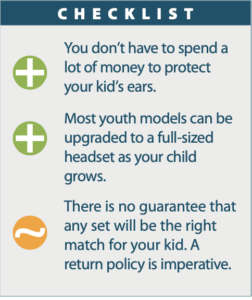
Our nine-year-old daughter Greta has been flying in our Cessna Cardinal RG since she was eight weeks old. We started her off with swimmer’s ear putty, and then at around six months we moved her to children’s hearing protectors. When she was around one year old and started watching videos, we bought her a child’s headset made by Softcomm, and it lasted over eight years until the speakers failed. We were in the market for a new kid’s headset.
Part of the process was talking with Sporty’s, which suggested some models that have been popular sellers over the past few years. Our thanks to them for sending a few of the samples, including a Sigtronics S-20Y and a David Clark H10-13Y—both youth-purposed headsets. Since David Clark’s supra-aural (on ear) Pro-X2 has a small footprint—and got high marks in the review in Aviation Consumer’s October 2019 field report—we included it.
I also broke out the soldering gun and replaced the speakers in the old Softcomm model and tossed the set into the mix. As far as we can tell, this set has been discontinued, but there might be some on the used market. We tried to experiment with an in-ear model, but Greta wanted no part of sticking buds in her ears. We suspect that will be the case with many younger kids—just as it is for some adults.
We evaluated audio quality in part by playing SXM’s E Street Radio through the aircraft’s audio system, and Greta could not distinguish a difference between the headsets in the group. Listening to Greta talk through the intercom, I could not distinguish any difference between the audio quality of the microphones—they were all quite good. The passive headsets had a volume control on the ear cup, and the Pro- X2 had separate volume controls for each earpiece on the control box so adjusting the volume to suit a kid is easy, although younger kids might struggle with the chore.
As for styling, while younger children might be attracted to a headset because of its color (and the Softcomm’s purple ear cups were a major selling point for Greta when she was a year old), at age 9 she couldn’t care less about color, other than to call them “green,” “purple” and “blue” during testing.
We took to the skies in our Cardinal and tried each set for roughly 30 minutes, paying attention to fit, finish and features.
HOW YOU MIGHT CHOOSE
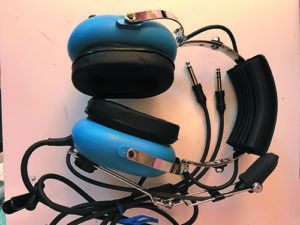
The most important thing to consider is that the best kid’s headset isn’t necessarily the one with the best performance or features. Instead, it is the one that your kid is willing to wear for hours at a time. So as with all headsets, getting return privileges is really important.
The second most important thing to consider is that little kids are perfectly happy watching the same 30-minute episode of Mickey Mouse Clubhouse over and over for an entire four-hour flight, but after the second time around the grown-ups are ready to open the doors and jump out (don’t ask us how I know that). It’s also a distraction to what at times should be a sterile cockpit.
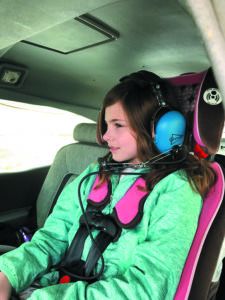
Unfortunately, an important feature that these headsets do not necessarily have is a separate input for headset-dedicated audio so the grown-ups don’t have to listen to it. Still, a dedicated isolated input allows the child to continue on the airplane’s intercom.
Of course, the most effective way to do that is with an intercom or audio panel that has multiple entertainment inputs that you can dedicate to your child’s intercom station. But for our purposes here, we would want a kid’s headset that has its own auxiliary music input jack.
There’s Bluetooth, too, of course, but in reality we consider that as secondary because many kids’ audio devices don’t have wireless capability. Further, the only Bluetooth-equipped model in the evaluation pool was the Clark Pro-X2 (which isn’t really a youth-purposed set). Only the Softcomm had a wired 3.5-mm input jack. The Pilot USA PA-1151ACG (we didn’t fly with it) is also so equipped.
Herewith are Greta’s impressions and my observations during flight trials.
DAVID CLARK H10-13Y
This was Greta’s favorite headset because it was the most comfortable of the three full enclosure models, perhaps due to its generously thick double-foam head pad. It weighs 16.5 ounces. It’s a passive headset, of course, but in kid language, yes, it blocked the most noise of the three. The tech specs say it has an NRR (noise reduction rating) of 23 dB. Not surprisingly it was the most expensive.
The microphone boom is a flexible one-piece design that’s easy to manipulate into almost any position, and it holds. You know what happens with loose-fitting mic booms that drop below the lips—forget about hearing the kid’s mic audio. Unless they have, well, loud mouths. But that’s another reason for an intercom with passenger volume and squelch controls. It’s nice to have as much control over the audio in the cabin as possible.
The mono-only H10-13Y has a single volume control, a well-performing M-7A amplified electret microphone and gel-filled ear seals.
Street priced around $320, the TSO’d H10-13Y is the most expensive of the over-ear models but there’s a saving grace: The set can be converted to a full-sized model with a $30 upgrade kit.
Visit www.davidclark.com.
SIGTRONICS S-20Y
This headset, street priced at around $160, came with a large and small headband. While this offers flexibility for a growing kid, we found that the large headband was a better fit for Greta so we used it in our trials.
Saying that, this headset was Greta’s least favorite because almost as soon as she put it on she complained of it pressing against her jawbone. Try as we might, we couldn’t find an adjustment that helped. After a while, Greta complained that the set became very uncomfortable.
As for performance, it did a good job of blocking noise, but not quite as good as the other two. The articulated microphone boom, although not as flexible as the David Clark’s, was easy to position. It’s worth noting that changing the microphone windscreen requires removing the microphone from the boom. We did not attempt to do that, but it did not appear to be a difficult job.
The S-20Y has a 24-dB NRR and weighs 12.4 ounces, so it is no surprise that it performed nearly as we’ll as the David Clark H10-13Y. The M-80 amplified electret microphone can be rotated for use on the left or right ear cup.
The ear cups are made of ABS plastic and the hardware is chrome plated and hardened steel, which makes the set durable. Sigtronics has what it calls a “stop-break” high-flex cable, and the company says the electronics are RFI and EMI free. Speaking of hardware, it comes with everything needed to convert it to an adult set. It has a three-year warranty.
Visit www.sigtronics.com.
PILOT USA CADET
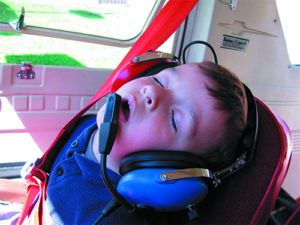
The company says it was the first to design an aviation headset for children and the $130 PA-1151-series Cadet is for kids between two and 12 years old. Since our evaluation was in the middle of the COVID-19 pandemic, we couldn’t get our hands on a fresh set for this review. But we’ve used them before with reasonably good results. The company was available to talk with us—a good sign when it comes to promised support.
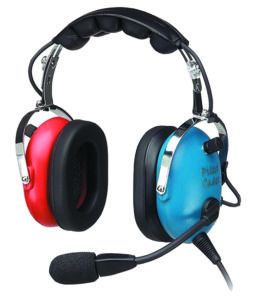
The set is in line with the other passive models in the group, with a 24-dB NRR and weighing 11.9 ounces. It has foam ear seals, and the set has 5-foot audio cables and a noise-canceling electret microphone. We like that it has a flexible microphone boom, which is sized smaller for kids.
The boom can be upgraded to a larger one (as can the headband) by sending it back to the company. This leaves room to grow. The set is available with pink ear cups or a version with a blue and red combination.
What we really like is the standard 3.5-mm aux input jack piping in audio. It has dual volume controls (one on each ear cup) and mono/stereo capability. Visit www.pilot-usa.com.
CAN ADULT SETS WORK?
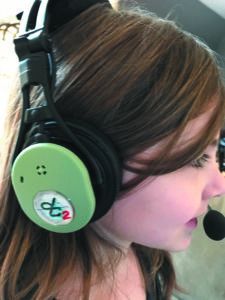
The answer is a cautious maybe. Sporty’s told us that the hugely popular Bose A20 is sometimes a successful choice for kids given their comfort and light weight. If you have them, simply try them. I’d have a hard time coughing up $1000 for a kid’s headset that will not be used that often. Of course, it’s also an adult headset, so if you consider it as a long-term purchase then maybe the cost isn’t so bad. My wife has been using an in-the-ear Lightspeed Mach 1 for a long time, and we still have a few replacement earpieces, although they’re getting hard to find for this long-discontinued model. Last summer I asked Greta if she wanted to try it out, but she was grossed out by the idea of stuffing something in her ears. I tried again when researching this report, but she still was not interested, and couldn’t even be bribed to do it.
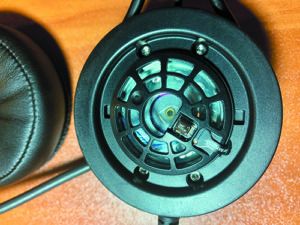
I was surprised when Greta wasn’t blown away by the well-performing David Clark Pro-X2. She agreed it was the lightest headset we tested, but did not think it was more comfortable than the H10-13Y. I was most surprised that she thought the H10-13Y filtered airplane noise better than the Pro-X2. I confirmed that she had powered it on correctly, and we tried several adjustments to the fit, but no matter how we tried, she still preferred the passive David Clark. This doesn’t mean the Pro-X2 can’t work for some kids.
THE TAKEAWAY
Our thanks to Sporty’s for providing some of the samples for the review. It’s hard to say anything definitive after trying these headsets for roughly a half-hour each on one kid, but if there is a general lesson it is to try them on in the store if you can (and even better in the airplane) and look for generous return privileges. It’s possible that the one your kid liked during a tradeshow demo will turn out to become uncomfortable after wearing them in the airplane.
Additionally, based on personal experience I’d strongly recommend a headset that allows the child to listen to something other than the music the grown-ups pipe through the aircraft audio system. That way the rest of us don’t have to listen to kiddie videos at the youngest ages or the head-pounding rock-and-roll I’m sure my daughter will like when she’s a few years older.
While the most expensive of the youth models, the $320 David Clark H10-13Y was a favorite, plus it can be easily upgraded to a full-sized model. If it had an aux audio input it would be a grand-slam winner. If aux audio is a must-have feature, we say try the $130 Pilot Cadet. If a particular model has worked for your kid, we want to hear about it.
Contributor Mark Klebanoff and his daughter Greta are Cessna Cardinal RG owners based in Ohio.

